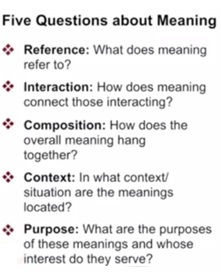Multimodal Literacies MOOC’s Updates
Academic Oral Expresion
Teaching academic oral expression is a complex task. Currently, I am confronting this challenge. I am now in charge of a class of pre-service teachers in a class that is supposed to prepare them to “speak in academic situations”.
In here I have found that probably one the most important things to do is to help students reflect that written language and oral language are different and, especially in such contexts, they can be complementary, but accounted differently.
Some examples of academic oral genres are conferences, debates, expositions, research reports, etc. In all of them, there is the necessity of using written language. But not only that, there is so much more involved such as graphics, body language and use of the space.
That is why I have found that the multimodal perspective suits perfectly for this class. The whole concept of synesthesia helps us understand the great value of using different resources to communicate effectively.
One type of exercise that can be made with the students using the multimodal perspective is the following:
Start point: Students are taking their research class this semester. Right now they completed writing their research proposal for the final project.
The goal of the term: Prepare a presentation to the Faculty Council to ask for funding for their research.
We start from the point that students have a written document with what they need to present.
So, what is next is to look for the best way of constructing a persuasive discourse effectively and make themselves understood in front of the Council.
Using the model for a multimodal grammar, students make a brainstorm of what resources they can have to their use and what will help with their presentations to be effective communicators.
After defining and working around the modes they will use for their presentation, students start constructing them using the questions that are used in the multiliteracies approach to analyzing texts:
Using this strategy helps them analyze their own texts and think about how all modes work together to compose an effective message. This continuous self-assessment not only helps them to complete their task but, this whole process starts shifting how they perceive and read messages and provides them with tools to be more critical when encountering messages in the future.
Finally, the clue is to do peer-assessment. Here, students present their messages to each other and give feedback on how all aspects, written and oral language plus all of the other modes hold together the message.
In conclusion, the multimodal perspective expands or views and makes us aware that speaking is not the same as writing; that both modes hold different factors that need to be asserted and worked around.




Nowadays,due to the variety of high technology we use in our daily life,the art of speeking has become much easier than writing , but that doesn't mean that we must ignore writing.It also needs some improvements.
The multimodal role and peer graded feedback help too in process writing as learners struggle with difficulties related to writing...
Hi Zulma,
I thought your article was excellent. You highlighted the importance of multimodal perspectives perfectly.
It is really only quite recently that the art of giving a presentation has become recognised as an important skill that people must aquire in the 21st century. It has even become a requirement at junior school level. Certainly when I was at school, even at university, the art of standing infront of an audience and presenting a topic wasn't taught. Nowadays, with the aray of high tech gadets, people have the means to give insightful, meaningful and engaging presentations.